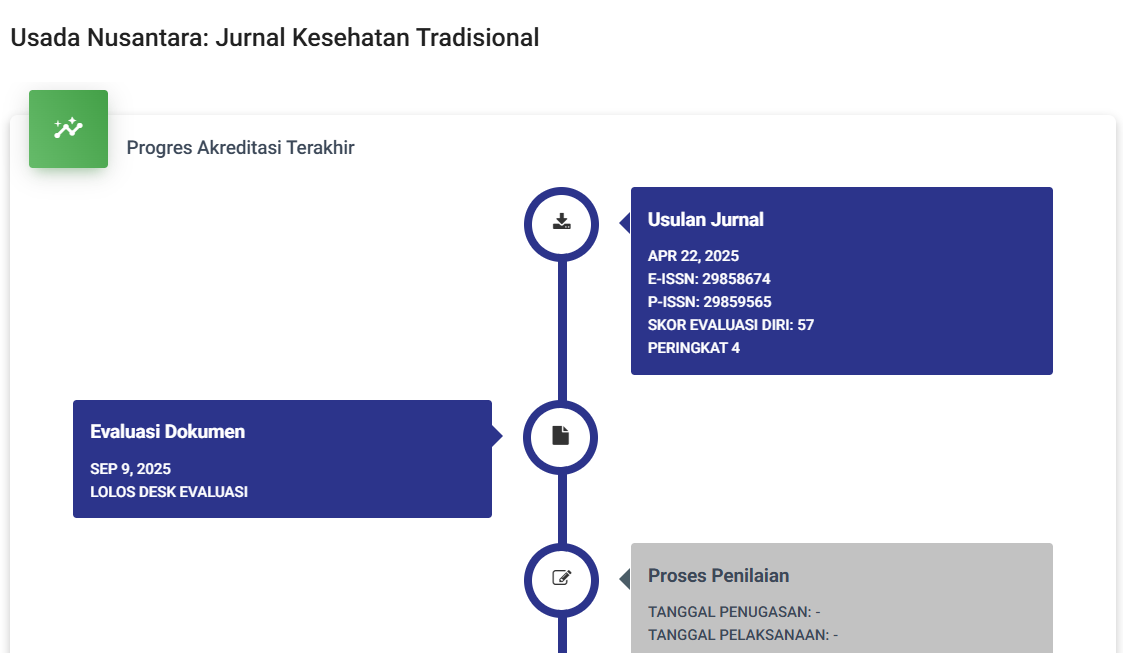PENERAPAN (ROM) PASIF PADA LANSIA DENGAN GANGUAN MOBILITAS FISIK DI PANTI GRIYA JANATI
DOI:
https://doi.org/10.47861/usd.v1i2.210Keywords:
Passive ROM, in the ElderlyAbstract
Introduction: Stroke is a major health problem for today's modern society. Today, stroke is becoming a serious problem worldwide. This is because a sudden stroke can result in death, physical and mental disability in productive and old age. Methods: This study used a qualitative approach with the case method. Sunberg (2007) explains that a case study is a report or narrative by a therapist about the treatment of a single client, even though the report could be about a family or a group. In addition, this study also uses "ABA Design" where A is the initial phase of the intervention (Baseline Phase), namely the target aspect of the behavior to be intervened, B is the treatment phase (Treatment Phase), which is the application of intervention techniques, then followed by A is the follow-up phase. follow-up phase, namely the phase of evaluating the progress of the intervention technique that has been given, and knowing whether the subject can maintain the behavior that has been intervened. Objective: to identify the muscle strength of stroke patients before and after ROM is carried out, and identify the effect of giving Range OF Motion (ROM) on muscle strength in stroke patients. Conclusion: The first patient, Mr. "S", motion exercises are more effective for the lower limbs or lower extremities, already able to be moved even though they are still assisted with activities, for the second patient Mrs. "V.S" complains of lower limbs or lower extremities, difficulty in doing activities , feeling dizzy, while for patient 3 Ny. "N.U" complained of dizziness, felt that his left limbs were weak and weak, had a history of stroke.
References
Basuki, L. (2018). Penerapan Rom (Range of Motion) Pada Asuhan Keperawatan Pasien Stroke Dengan Gangguan Mobilitas Fisik Di Rsud Wates Kulon Progo. In Politeknik Kesehatan Kemenkes Yogyakarta. http://eprints.poltekkesjogja.ac.id/2125/1/KARYA TULIS ILMIAH LENGKAP.pdf
HADIJAH. (2020). Faktor-Faktor Yang Berhubungan Dengan Kejadian Provinsi Sulawesi Selatan Sekolah Tinggi Ilmu Kesehatan Panakkukang Makassar Program Studi S-1 Keperawatan Makassar. 103.
HARDIKA TAMBA, M. M. (2019). Gambaran Karakteristik Penyakit Stroke Rawat Inap Di Rumah Sakit Santa Elisabeth Medan Tahun. Repository STIKES Santa Elisabeth Medan.
KIKI PUTRI APRILIYANI. (2021). Pencegahan Stroke Pada Lansia Dengan Hipertensi: Literatur Review. 5–9.
Nurshiyam, N., Ardi, M., & Basri, M. (2020). Nursing Care in Meeting Physical Mobility Needs Inpatients Non Hemorrhagic Stroke in Rskd Dadi Makassar. Media Keperawatan: Politeknik Kesehatan Makassar, 11(1), 90. https://doi.org/10.32382/jmk.v11i1.1555
Rofifah, D. (2020). FAKTOR RESIKO TERHADAP KEJADIAN STROKE Di RSUD Dr. KOESNADI BONDOWOSO. Paper Knowledge . Toward a Media History of Documents, 12–26.
Safa’ah, N. (2013). Pengaruh Latihan Range of Motion terhadap Peningkatan Kekuatan Otot Lanjut Usia di UPT Pelayanan Sosial Lanjut Usia ( Pasuruan ) Kec . Babat Kab Lamongan. Jurnal Sains Medical, 5(2), 62–65. https://www.kopertis7.go.id/uploadjurnal/Nurus_Safaah_stikes_nu_tuban.pdf
Sianipar, N., Pangaribuan, R., & Tarigan, J. (2021). Pemenuhan Kebutuhan Aktivitas Pada Lansia Dengan Rheumatoid Arthritis (RA) Di UPT Pelayanan Lanjut Usia Binjai. MAHESA : Malahayati Health Student Journal, 1(3), 270–283. https://doi.org/10.33024/mahesa.v1i3.5048
Suminar, I. D., Maunaturrohmah, A., & Rahmawati, A. (2018). Pengaruh Range of Motion (Rom) Aktif Terhadap Kekuatan Otot Pada Penderita Stroke Non Hemoragik. Doctoral Dissertation, STIKes Insan Cendekia Medika Jombang)., 2, 227–249.








